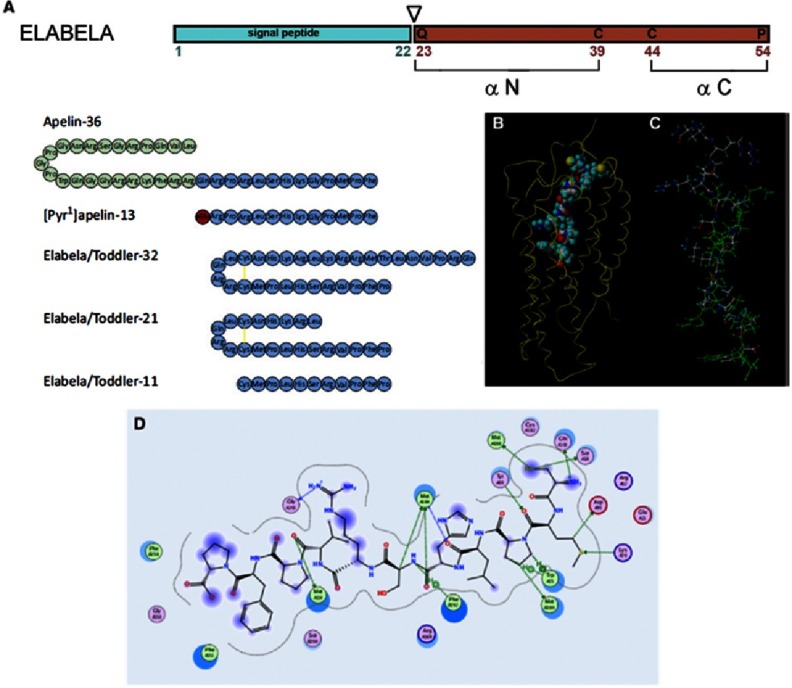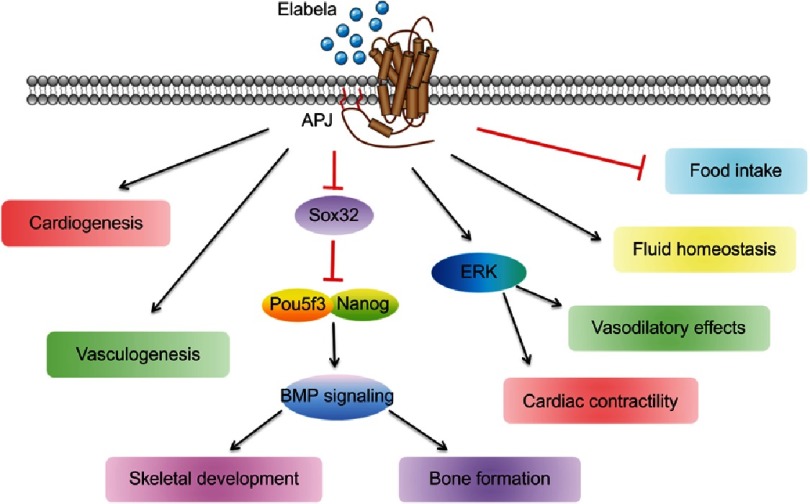Abstract
Background. Despite significant therapeutic advances, heart failure (HF) remains unacceptably high in morbidity and mortality. Additionally, its high-care and costs make HF a deadly and costly disease. First reported independently by two group of researchers, Apela/Elabela/Toddler (ELA) is the second endogenous apelin-receptor ligand discovered which is encoded from a previously classified non-coding gene, and has emerged as a key signalling-pathway in the cardiovascular system.
Aims. To explore and summarise the biological effects and diagnostic potential of ELA as a new biomarker for heart failure.
Results. ELA (prepro-ELA 54 AA) is a molecule with three isoforms (ELA 11,16 and 32), recently identified as the second endogenous ligand to APJ-receptor and functions to mediate early cardiac development during zebrafish embryogenesis by inducing cardiogenesis, vasculogenesis and bone formation. In adults, it enhances cardiac contractility, promotes vasodilatory effects, mediates fluid homeostasis, reduces food intake, limits kidney dysfunction and exerts anti-atherosclerotic as well as anti-oxidative properties.
Conclusion. These results show that ELA, an endogenous agonist of the APJ-receptor exerts cardiovascular effects comparable and potentially more potent than apelin and is found to be downregulated in experimental models and humans with heart failure.
Introduction
Heart failure is a complex clinical syndrome resulting in a reduced ability of the heart to pump and/or fill with blood, and is considered the fatal finishing line of all cardiovascular disorders. Despite significant therapeutic advances, heart failure (HF) remains unacceptably high in morbidity and mortality. Additionally, its high care requirements and associated costs make HF not only a deadly disease, but also a costly one. In 2014 an estimated 26 million people worldwide suffered with heart failure. In 2012 the United States reported over 10% of its total health expenditure (USD 31 billion) was spent on cardiovascular diseases with total costs expected to increase by 127% between 2012 and 20301,2.
Significant efforts have been made in searching for new HF biomarkers3. First reported independently by two different group of researchers – Chng et al.4 and Pauli et al5, Apela/Elabela/Toddler (ELA) is the second endogenous apelin-receptor ligand discovered encoded from a previously classified non-coding gene and has emerged as a key signalling-pathway in the cardiovascular system.
Apelin-APJ axis
Apelin is an endogenous hormone that binds to apelin receptors and exerts potent positive inotropic activity and increases coronary blood flow by vascular dilation, thereby providing beneficial effects in failing hearts6. The APJ, or apelin, receptor is a G-protein coupled receptor which shares similarity in homology to that of the angiotensin II type 1 receptor (54% homology in transmembrane domains and 32% homology for the entire sequence)7,8. Hence, the APJ system was found to negatively regulate angiotensin II signalling and upregulates angiotensin-converting enzyme 2 (ACE2) expression9. The Apelin-APJ axis was reported from mouse models to maintain heart contractility and cardioprotective effects under conditions of pressure overload, exercise and ageing10,11.
Elabela/Toddler/Apela (ELA)
Earlier apelin has been thought to be the only ligand of the apela receptor, however recently ELA has been identified as the second endogenous ligand to this receptor. ELA (prepro-ELA 54 AA) is a molecule with 3 isoforms (ELA 11,16 and 32)12 and functions to mediate endoderm differentiation and cell migration hence promoting early cardiac development during zebrafish embryogenesis by inducing cardiogenesis, vasculogenesis and bone formation. Severe developmental defects including rudimentary or absent heart formations have been reported following ELA mutation similar to the effects of mutation of the Apela receptor4,5 (Figures 1 and 2).
Figure 1. A – Sequence of apelin and Elabela/Toddler peptides4,14; B – Docking of ELA-11 on the apelin receptor; C – Apelin-13 (multicolored atoms) and ELA-11 (green) docking showing overlap in the binding site; D – Ligand interaction diagram showing key close contacts between ELA-11 and the apelin receptor model; ELA indicates Elabela/ Toddler/Apela12.
Figure 2. ELA’s effect during cardiogenesis4,13.
Recent studies have also shown the potential effects of ELA in the self-renewal of human embryonic stem cells (hESC) in an autocrine manner which may be a result of its interaction with another unknown alternate receptor (receptor X)13 (Figure 2).
In adults, ELA has been found localized in the endothelium and has an affinity for the human apelin receptor4. In addition, ELA has also been reported to be detected only in human stem cells (embryonic and induced adult pluripotent stem cells), and kidney unlike APJ receptors which have been reported to be found in heart, kidney, brain, lung, stomach, pancreas, fats and stem cells13,15. Hence, ELA was found to enhance cardiac contractility, promote vasodilatory effects, mediate fluid homeostasis, reduce food intake, limit kidney dysfunction and exerts anti-atherosclerotic as well as anti-oxidative properties16 (Figure 3).
Figure 3. ELA’s effect during embryogenesis and in adults16.
With regards to fluid homeostasis, due to its greater distribution in the kidneys than apelin, ELA infusion resulted in a response 5 times that of apelin17. ELA treatment significantly suppressed the increased expression of mRNA associated with cardiac hypertrophy, such as brain natriuretic peptide (BNP), atrial natriuretic factor (ANF), and b-myosin heavy chain (b-Myhc)7, as well as markers of markers of myocardial injury such as lactate dehydrogenase (LDH), creatinine kinase-MB (CK-MB), Troponin I and markers of oxidative stress such as membrane lipid peroxidation (MDA), glutathione (GSH) and superoxide dismutase activities (SOD). Animal studies have also reported that cardiac function as measured by echocardiography improved significantly 2 weeks after ELA infusion post myocardial infarction18.
Conclusion
These results show that ELA is an endogenous agonist of the APJ receptor exerting cardiovascular effects comparable and potentially more potent than apelin and downregulated in experimental models and humans with heart failure. ELA’s discovery open new possibilities in the field of biomarkers and therapeutics of heart failure due to its significance in the pathophysiology of heart failure. Further studies on ELA and APJ signalling are needed to provide more mechanistic insights into regulation and activation of APJ in cardiovascular diseases.
Conflict of Interest
The authors declare no conflict of interest with regards to this publication.
References
- 1.Iqbal N, Wentworth B, Choudhary R, Landa AD, Kipper B, Fard A, et al. Cardiac biomarkers: new tools for heart failure management. Cardiovasc Diagn Ther. 2012;2(2) doi: 10.3978/j.issn.2223-3652.2012.06.03. [DOI] [PMC free article] [PubMed] [Google Scholar]
- 2.Savarese G, Lund LH. Global Public Health Burden of Heart Failure. Card Fail Rev. 2017;3(1) doi: 10.15420/cfr.2016:25:2. [DOI] [PMC free article] [PubMed] [Google Scholar]
- 3.Correale M, Monaco I, Brunetti ND, Biase MD, Metra M, Nodari S, et al. Redefining biomarkers in heart failure. Heart Failure Reviews. 2018 doi: 10.1007/s10741-018-9683-2. [DOI] [PubMed] [Google Scholar]
- 4.Chng SC, Ho L, Tian J, Reversade B. ELABELA: a hormone essential for heart development signals via the apelin receptor. Developmental Cell. 2013;27(6) doi: 10.1016/j.devcel.2013.11.002. [DOI] [PubMed] [Google Scholar]
- 5.Pauli A, Norris ML, Valen E, Chew GL, Gagnon JA, Zimmerman S, et al. Toddler: an embryonic signal that promotes cell movement via Apelin receptors. Science. 2014;343(6172) doi: 10.1126/science.1248636. [DOI] [PMC free article] [PubMed] [Google Scholar]
- 6.Japp AG, Cruden NL, Barnes G, van Gemeren N, Mathews J, Adamson J, et al. Acute cardiovascular effects of apelin in humans: potential role in patients with chronic heart failure. Circulation. 2010;121 doi: 10.1161/CIRCULATIONAHA.109.911339. [DOI] [PubMed] [Google Scholar]
- 7.Sato T, Sato C, Kadowaki A, Watanabe H, Ho L, Ishida J, et al. ELABELA-APJ axis protects from pressure overload heart failure and angiotensin II-induced cardiac damage. Cardiovascular Research. 2017;113 doi: 10.1093/cvr/cvx061. [DOI] [PubMed] [Google Scholar]
- 8.Xu J, Chen LX, Jiang Z, Li L. Biological functions of Elabela, a novel endogenous ligand of APJ receptor. Journal of Cellular Physiology. 2018 doi: 10.1002/jcp.26492. [DOI] [PubMed] [Google Scholar]
- 9.Sato T, Suzuki T, Watanabe H, Kadowaki A, Fukamizu A, Liu PP, et al. Apelin is a positive regulator of ACE2 in failing hearts. J Clin Invest. 2013;123 doi: 10.1172/JCI69608. [DOI] [PMC free article] [PubMed] [Google Scholar]
- 10.Kuba K, Zhang L, Imai Y, Arab S, Chen M, Maekawa Y, et al. Impaired heart contractility in Apelin gene-deficient mice associated with aging and pressure overload. Circ Res. 2007;101 doi: 10.1161/CIRCRESAHA.107.158659. [DOI] [PubMed] [Google Scholar]
- 11.Charo DN, Ho M, Fajardo G, Kawana M, Kundu RK, Sheikh AY, et al. Endogenous regulation of cardiovascular function by apelin–APJ. Am J Physiol Heart Circ Physiol. 2009;297 doi: 10.1152/ajpheart.00686.2009. [DOI] [PMC free article] [PubMed] [Google Scholar]
- 12.Yang P, Read C, Kuc RE, Buonincontri G, Southwood M, Torella R, et al. Elabela/Toddler is an endogenous agonist of the apelin APJ receptor in the adult cardiovascular system, and exogenous administration of the peptide compensates for the downregulation of its expression in pulmonary arterial hypertension. Circulation. 2017;135 doi: 10.1161/CIRCULATIONAHA.116.023218. [DOI] [PMC free article] [PubMed] [Google Scholar]
- 13.Ho L, Tan SY, Wee S, Wu Y, Tan SJ, Ramakrishna NB, et al. ELABELA is an endogenous growth factor that sustains hESC self-renewal via the PI3K/AKT pathway. Cell Stem Cell. 2015;17 doi: 10.1016/j.stem.2015.08.010. [DOI] [PubMed] [Google Scholar]
- 14.Yang P, Maguire JJ, Davenport AP. Apelin, Elabela/Toddler, and biased agonists as novel therapeutic agents in the cardiovascular system. Trends Pharmacol Sci. 2015;36(9) doi: 10.1016/j.tips.2015.06.002. [DOI] [PMC free article] [PubMed] [Google Scholar]
- 15.Wang Z, Yu D, Wang M, Wang Q, Kousnetsova J, Yang R, et al. Elabela-apelin receptor signaling pathway is functional in mammalian systems. Sci Rep. 2015;5 doi: 10.1038/srep08170. [DOI] [PMC free article] [PubMed] [Google Scholar]
- 16.Lu L, Cao J, Li L, Chen L. Elabela, a new endogenous ligand of APJ, functions in embryos and adults organisms. Acta Biochimica et Biophysica Sinica. 2017;49(4) doi: 10.1093/abbs/gmx014. [DOI] [PubMed] [Google Scholar]
- 17.Deng C, Chen H, Yang N, Feng Y, Hsueh AJ. Apela regulates fluid homeostasis by binding to the APJ receptor to activate GI signalling. Journal of Biological Chemistry. 2015;290(30) doi: 10.1074/jbc.M115.648238. [DOI] [PMC free article] [PubMed] [Google Scholar]
- 18.Rakhshan K, Azizi Y, Naderi N, Afousi AG, Aboutaleb N. ELABELA (ELA) peptide exerts cardioprotection against myocardial infarction by targeting oxidative stress and the improvement of heart function. International Journal of Peptide Research and Therapeutics 2018 [Google Scholar]





